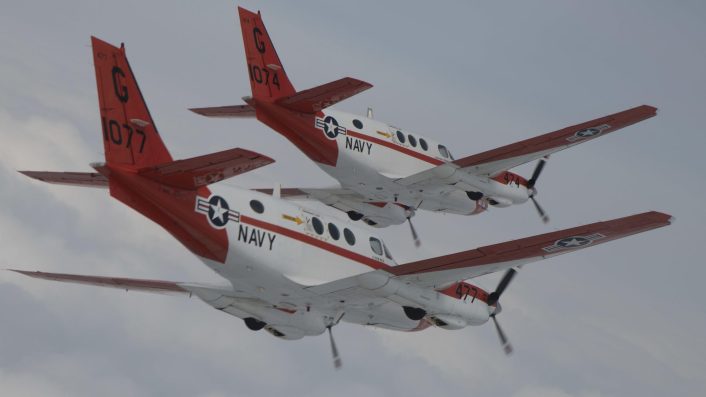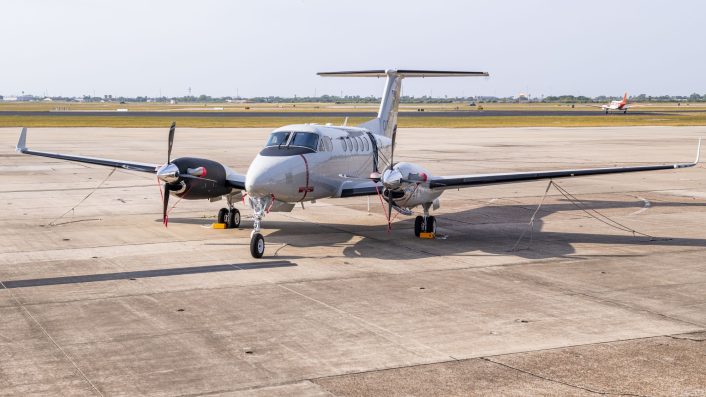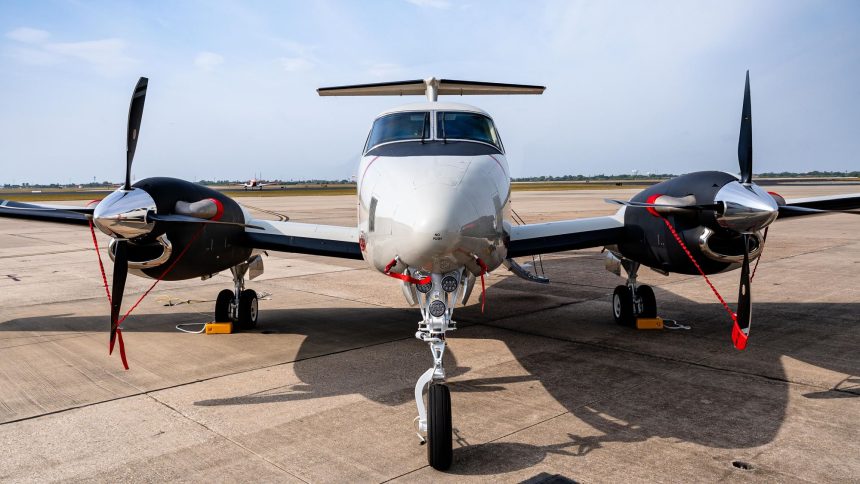The T-54A Marlin reached the Initial Operational Capability and will now train student naval aviators that will be assigned to aircraft like the P-8A Poseidon and E-2 Hawkeye.
The U.S. Navy has declared the Initial Operational Capability (IOC) for the T-54A Marlin II training aircraft in May, Naval Air Systems command (NAVAIR) announced on Jun. 9, 2025, “giving future naval aviators a modern platform to prepare them for the advanced aircraft they will fly in the fleet.” A variant of the Beechcraft King Air 260, the Marlin will replace the older T-44C Pegasus that has been in service since 1977 and the service plans to phase out gradually.
The aircraft features a pressurized cockpit, side-by-side seating arrangement, a host of current avionics, electronics, modern digital flight instrumentation as well as a jump seat for another person to be in the cockpit. The Navy will employ the T-54A to train pilots that will later go on to fly on fixed wing aircraft like the Boeing P-8A Poseidon Maritime Patrol and Anti-Submarine Warfare (MPA-ASW) aircraft, E-2D Hawkeye AEW&C (Airborne Early Warning and Control) aircraft and C-130 Hercules. It would also meet the training needs of the U.S. Coast Guard and select U.S. allies through 2055.
The @USNavy’s T-54A Marlin II is ready for action—IOC declared in May. Replacing the T-44C, it preps #Navy, #MarineCorps, #CoastGuard & allies for next-gen aircraft. 15 delivered to the Navy so far, more coming through 2026!
Read more here: https://t.co/Do2rCYglbL pic.twitter.com/3E5O3YWbzZ
— NAVAIR (@NAVAIRNews) June 10, 2025
The press release from NAVAIR added the T-54A Marlin provides“advanced instrument and asymmetric engine handling training” which will help to better prepare “student naval aviators selected for multi-engine and tilt-rotor fleet communities.” The mention of tilt-rotors implies training for the CMV-22B Osprey used by the U.S. Navy for ship-to-ship logistics and the Marine Corps’ MV-22B Osprey variant. The CVM-22B Osprey is poised to gain prominence in the role as the service phases out the older C-2 Greyhound aircraft.
T-54A Marlin deliveries
As per NAVAIR, the Navy has so far received 15 T-54A aircraft, with plans to procure up to 64 airframes, according to the 2023 contract with Textron. The company later received an additional order in 2024, with aircraft deliveries scheduled to continue through the calendar year 2026.
The T-54A and the T-44C acquisitions are managed by the Program Executive Office for Tactical Aircraft Programs (PMA-273). The office “develops and oversees diverse and carrier-capable naval flight training systems where student pilots and undergraduate military flight officers acquire mission-critical aviation skills necessary to carry out current and future missions of the U.S Navy,” according to NAVAIR’s description.

The first T-54A Marlin reached Naval Air Station (NAS) Corpus Christi in Texas on Apr. 18, 2024. A Navy release at the time said the T-54A “heralds a new generation of Naval Aviators who will use the trainer to earn their wings of gold,” as they train to fly aircraft like the P-8A, E-2D and C-130.
On Mar. 27, 2025, the Navy reported a pair of T-54A Marlins completed their “first cross-country flight to Washington state, showcasing the range capacity as the Navy’s newest multi-engine trainer.” On that occasion, the two aircraft arrived at NAS Whidbey Island in Washington.
New tradition in Naval Aviation training fleet
The T-54A Marlin has a 43-foot (13-meter) long airframe, a wingspan of 57 feet (17 meters), and is powered by two Pratt & Whitney PT6A-52 engines, each producing 550 horsepower. It can touch distances of 1,640 nautical miles (3,037 km), a speed of 480 km/hour, and reach an altitude of 35,000 feet. The T-54A aircraft is also painted gray – a shift from the orange and white paint scheme the Navy has employed for 70 years on trainer aircraft.
The release announcing the arrival of the first two T-54As at NAS Corpus Christi on Apr. 18, 2024 and identifying it as the new Multi-Engine Training System (METS), explained the T-54A “glossy grey” colour paint scheme “reflects similar paint coats of the P-8A and E-2D.” The T-44C Pegasus sported a red-on-white paint scheme.

The “glossy grey” paint scheme was announced alongside a “Midway” blue paint coat for the Chief of Naval Aviation Training’s (CNATRA) T-6B Texan II aircraft, in “an effort to reconnect students and instructors with the fleet,” said the service. “The T-44C Pegasus trained generations of Naval Aviators seeking to fly multi-engine platforms. So the arrival of the T-54A is a truly historic moment. The new aircraft is not painted orange and white like the previous 70 years of naval air training. The new grey paint scheme is designed to bolster pride not only in our students but in our instructors,” Capt. Michael Albus, commander of the Training Air Wing 4 (TAW-4) said at the time.
Boost in training programs
In the NAVAIR release, PMA-273’s Naval Undergraduate Flight Training program manager Capt. Duane Whitmer said the IOC reflects their “commitment to provide student naval aviators with the most realistic, effective training aircraft to equip them for today’s complex battlespace.” The aircraft’s technology also captures data that allows for condition-based maintenance, a capability that enables the Navy to trend aircraft health over time to facilitate improved maintenance planning and efficiency.
The release about the arrival of the first two T-54As at NAS Corpus Christi said the T-44C “successfully served generations of Naval Aviators after continuously supporting Training Air Wing (TAW) 4 efforts to routinely exceed Naval Aviator production requirements each year.” Around the time, the TAW-4 effectively employed the T-44C in achieving 110% of fiscal year 2023 requirements for Naval Aviator production.
The Navy’s newest training aircraft has officially been dubbed the “T-54A Marlin II.” Scheduled to be in service through 2055, the T-54A has since reached 1,000 flight hours after the Chief of Naval Air Training completed the T-54A Safe-For-Flight certification in June 2024. pic.twitter.com/5Ptu6buklB
— NAVAIR (@NAVAIRNews) November 18, 2024
“But as aviation and maritime warfare continue to evolve, the T-54A has arrived to better help Student Naval Aviators prepare for the future,” added the statement. Capt. Albus, who at the time was tasked with overseeing the introduction of the T-54A into the Navy’s two premier multi-engine training squadrons, Training Squadron (VT) 31 and VT-35, said that the T-54A’s ProLine Fusion avionics suite and increased range, speed, and altitude ensure that “aviators are well-prepared to operate complex fleet aircraft, and are ready for […] a multi-domain environment.”









